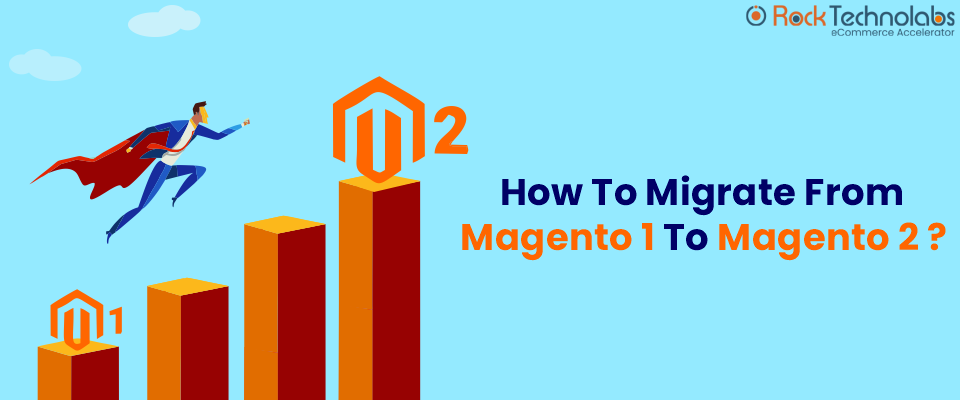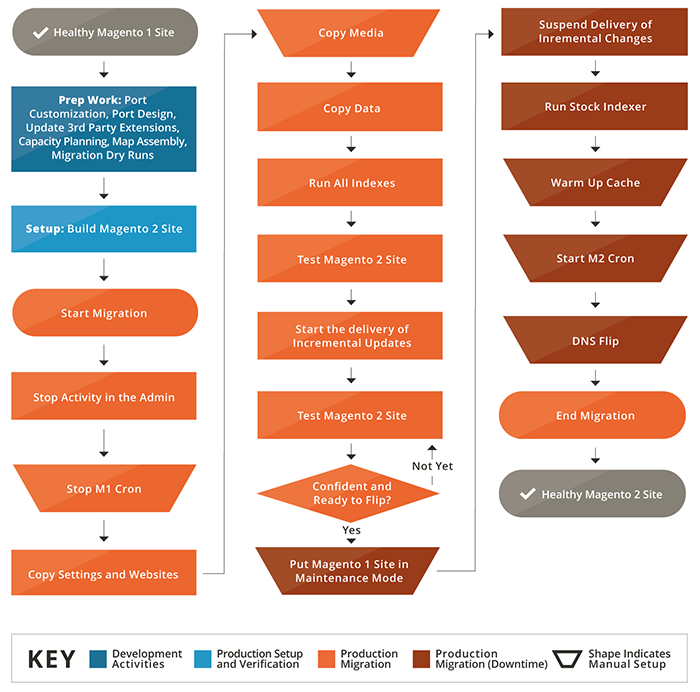Magento 2 Migration Steps: What You Need to Know

Magento 2 was launched in July 2015, and since then, the e-commerce enterprise platform owners are focused on shifting from Magento 1 to Magento 2. Magento 1 End of Lifehas been acknowledged among online merchants and e-commerce experts. Magento 2 has a completely different architecture than Magento 1 that supports PHP 7, full-page cache by default, and the highest speed. The user-friendly checkout method and database optimizations make Magento 2 the smartest choice among E-commerce store merchants and prove to be a number one choice for E-commerce store merchants. Many brands mistaken the migration as an upgrade, which is wrong. The migration is focused on moving from Magento 1 to Magento 2, like changes in database structure, themes and new API.
Magento 2 migration steps require a certain level of technical skills. This may lead you to think on how to migrate to Magento 2? Therefore, it is always necessary to frame a checklist before hiring Magento experts. The experienced professionals of your company should interview certified Magento 2 developersto convey the company’s requirements and test them accordingly. Magento has ended its support for Magento 1 in June 2020; therefore, it is high time to hire a Magento expert and migrate your store.
This blog will enclose some details on the Magento 2 migration process on why it is necessary to migrate and the Magento 1 to 2 migration steps.
Why is it so important to migrate from Magento 1 to Magento 2?
Magento 1 support has ended. Magento1 is outdated and won’t work anymore. Since the launch of Magento 2, ecommerce retailers are focused on using it in their store platform. Magento 2 is equipped with advanced features like PhP7 support, less Javascript to decrease useless browser operations on the client’s side, in-built tools for image compression and improved browser caching for the static content. It has a user-friendly checkout method with improved website loading speed and data optimization.
Better performance and scalability is one of the primary reasons for migration. The web design of Magento 2 helps deliver an improved shopping experience that supports mobile and desktop versions. The updation of extensions is easy with HTML5, LESS, and CSS3. The Ajax technology in Magento 2 prevents the simultaneous loading of the cart page when a user adds a product to the cart. It reduces the page loading time and bounce rate to improve the customer experience. It facilitates the Magento developers to write the test cases to check whether the customization has any negative effects on the functionalities. It also offers the integration of payment methods, including Paypal and Braintree.
Some important points that should be considered before migrating to Magento 2
Before planning the Magento 2 migration steps, it is important to take notes, backup and Magento 1 store details. This is because Magento 2 is about making changes in database structures, themes and working with a new API. Therefore, before migration, several aspects need to be considered.
● Analyze the website
Check the website’s compatibility related to the theme, code, extensions in the latest Magento version.
● Backups
Take the backup of Magento 1 store, including database, folders, and files.
● Copy Magento 1 store
Avoid using live stores for migration. Instead, migrate the data from the cloned database of the previous store to achieve minimum to zero downtime.
Hardware & Software requirements
Magento 2 will not perform efficiently if you have PHP 5. Some necessities need to be installed in M2 to get the most out of it.
➔ Software requirements
- PHP: 7.0.13 or 7.1.x
- PHP Extensions: bc-math, iconv, json, zip, libxml, ctype, curl, dom, intl, gd, hash, openssl, mbstring, mcrypt, PDO/MySQL, SimpleXML, spl, soap.
- MySQL: 5.6, 5.7 or Percona 5.7 or MariaDB 10.0, 10.1, 10.2.
➔ Hardware requirement
- RAM: Minimum 2GB
- Drive: 24GB SSD
Solid State Drives (SSD) allow M2 to run faster.
So, it is important to create a proper Migration Plan before starting Magento 2 Migration. Below is a Migration flow diagramto help you understand the process.

What are the possible methods for Magento 2 migration?
The manual upgradation to Magento 2 using Magento Migration Tool needs high technical skills.The basic skill requirements include fixing code, backing up databases, and repairing or fixing corrupted databases.
• Manual upgrade by using Magento migration tool
A manual upgradation using Magento Migration Tool needs high technical skills. The basic skill requirements include fixing code, backing up databases, and repairing or fixing corrupted databases.
• Hire Magento 2 developer
The cost of hiring a Magento developer depends on their skills, experience and qualifications. The most common method to pay for the services is by the hour in which the developer works on the front end, back end work, and looks after the website’s technical improvisations. The manual upgradation using Magento Migration Tool needs technical skill. Here you have to deal with code fixing, database backup and repair or fix corrupted databases.
• Use of Automated migration service
The automation migration method is one of the most advanced methods to migrate data from Magento 1 to Magento 2. It helps you migrate products from Magento 1 to Magento 2 and transfer customers, orders, multistore and CMS pages. The tool provides more options to expand the migration possibility, including customer password and SEO URLs migration.
How to migrate from Magento 1 to Magento 2?
Magento 1 to Magento 2 migration steps are given as follows:-
1. Theme Migration
Magento 2 launched new methodologies and technologies for delivering improved shopping and store experience to merchants and users. The developers can take advantage of new methods for developing smart Magento 2 themes or modify the prevailing themes to make them compatible with the Magento 2 standards. However, you cannot directly migrate from Magento 1 theme to Magento 2. Instead, various steps need to be followed:
- Check if the Magento 1 theme is compatible with the version of Magento 2.
- If it is compatible, then you can install the theme in Magento 2. It will make migration easier.
- In the absence of compatibility, you can create a custom theme in Magento 2 or buy and install the in-built Magento 2 theme from the marketplace.
-
2. Extension Migration
The second step of migration is to install the desired Magento 2 extensions available on the Magento marketplace. The Magento 1 extensions are not compatible with Magento 2; therefore, you will experience severe compatibility problems while integrating Magento 1 extensions into Magento 2.
There are several steps in extension migration
- Here also, you have to check if Magento 1 extensions are compatible with Magento 2 version.
- If yes, then you can consolidate the same extensions in Magento 2.
- In other cases, you have to include new extensions with the same functions after moving to Magento 2.
-
3. Customizations Migration
In most cases, custom code utilized by Magento 1 store is compatible with Magento 2. Magento offers a Code Migration Toolkit that helps in this process. However, due to structural differences in the platforms, the Magento migration may need additional efforts to ensure that the custom code is successfully integrated with the Magento 2 store.
The steps for customized migration are:
- The Code Migration Tool can be used to do Magento 2 customization.
- The tool can decrease the work involved in the code migration.
- In most cases, after running the toolkit, you have to edit some files manually.
-
4. Data Migration
The last step is to move your Magento 1 settings and data to Magento 2. Magento has officially launched that allows developers to migrate their store data and settings using CLI commands to ease this step. This tool makes the migration process easier and allows migrating critical data, including products, categories, orders, store configurations & settings, to Magento 2.
There are different steps involved in data migration:
Install Data Migration Tool through Composer
● You have to make sure that the Data Migration tool version and the Magento 2 version are the same. For example, if you are using Magento v2.1.1, then you have to install the Data Migration Tool v2.1.1.
After that, navigate to the root directory of the Magento 2 terminal and follow this command.
php bin/Magento –version
● You know the version of the Magento 2 store installs the Data Migration Tool. It is mandatory to update the location of the Data Migration Tool package in the composer.json file in the root directory of Magento 2. You can run this command:
composer config repositories.magento composer https://repo.magento.com Composer require magento/data-migration-tool:
In this code, is the Data Migration Tool version. For example, for the Data Migration tool for
Magento v2.1.1. you have to replace with 2.1.1
Composer require magento/data-migration-tool:2.1.1
● Enter the authentication keys
You have to go to Magento Marketplace > Sign in > Click on My Access Keys
If you have keys, then the public key is your username, and the private key is your password. Otherwise, you can generate a new key pair. Click on “Create a New Access Key Button.”
Configure Data Migration Tool
Following the installation, you will find the directories given below to contain mapping and configuration files for the Data Migration Tool:
/vendor/magento/data-migration-tool/etc/ce-to-ee
This includes configuration and scripts to migrate from Magento 1 Community Edition to Magento 2 Enterprise Edition.
For migration from Magento 1 Enterprise Edition to Magento 2 Enterprise Edition, use this command:
/vendor/magento/data-migration-tool/etc/ee-to-ee
Before migrating any data and settings to Magento 2, create a config.xml file in the relevant directory.
Where
: has Magento 1’s database information
: has relevant information of Magento 2
: encryption key of Magento 1 which can be found in tag for /app/etc/local.xml file.The last step is to save the config.xml file.
Migrate Settings
Utilize the Data Migration Tool to migrate settings from Magento 1 to Magento 2. This includes stores, websites, system configurations including tax settings, payment, shipping, etc. You should migrate the setting first. To start this, navigate to your Magento 2 root directory through SSH terminal and run this command:
php bin/magento migrate:settings –reset Where is vendor/Magento/data-migration-tool/etc/ce-to-ee//config.xml.
After successful migration from Magento 1 to Magento 2, a message will be displayed.
Furthermore, to migrate orders, products, wish lists, categories, ratings use this command:
php bin/Magento migration:data –reset
After successful migration, you have to set up the Magento store.
Magento 2 Advantages
Magento 2 has been launched with advanced features and functions, and it is a boon over Magento 1. There are many advantages of Magento 2One of the main reasons why you choose Magento 2 is due to security reasons. Magento 2 has been launched with increased security features. One of the options is SHA-256 (Secure Hash Algorithm 256) for securing passwords, focused on making it a dictionary attack, therefore the chances of succeeding it null.
Additionally, Magento 2 also has a fraud protection system called Signifyd . The feature allows the platform to recognize and abandon orders that seem to be fraudulent. This allows it to deliver more chargeback protection.
There is an additional feature in Magento 2 called page builder, PWA (Progressive Web Applications). It is one of the superior robust e-commerce solutions with improved speed, security and performance.
The merchants can check the difference between Magento 1 vs. Magento 2 to choose the best for their store. These benefits of Magento 2 allow you to acknowledge the difference and utilize the same knowledge to improve the security and performance of their ecommerce store.
Conclusion
Magento2 is a boon to ecommerce store owners to get the best return on investment (ROI). Mangento certified experts help in easing your Magento 2 migration steps. You can also hire Magento 2 experts to satisfy your requirements. It is a perfect eCommerce solution for businesses.
In today’s scenario, most of the eCommerce websites are opting for Magento migration services . Switching to Magento 2 helps in improving your ecommerce business with good returns on investments. We can help you in easing your migration process, as we have years of experience in this field.





